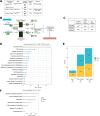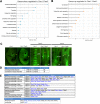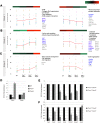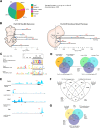A developmental transcriptomic analysis of Pax1 and Pax9 in embryonic intervertebral disc development
- PMID: 28011632
- PMCID: PMC5312110
- DOI: 10.1242/bio.023218
A developmental transcriptomic analysis of Pax1 and Pax9 in embryonic intervertebral disc development
Abstract
Pax1 and Pax9 play redundant, synergistic functions in the patterning and differentiation of the sclerotomal cells that give rise to the vertebral bodies and intervertebral discs (IVD) of the axial skeleton. They are conserved in mice and humans, whereby mutation/deficiency of human PAX1/PAX9 has been associated with kyphoscoliosis. By combining cell-type-specific transcriptome and ChIP-sequencing data, we identified the roles of Pax1/Pax9 in cell proliferation, cartilage development and collagen fibrillogenesis, which are vital in early IVD morphogenesis. Pax1 is up-regulated in the absence of Pax9, while Pax9 is unaffected by the loss of Pax1/Pax9 We identified the targets compensated by a single- or double-copy of Pax9 They positively regulate many of the cartilage genes known to be regulated by Sox5/Sox6/Sox9 and are connected to Sox5/Sox6 by a negative feedback loop. Pax1/Pax9 are intertwined with BMP and TGF-B pathways and we propose they initiate expression of chondrogenic genes during early IVD differentiation and subsequently become restricted to the outer annulus by the negative feedback mechanism. Our findings highlight how early IVD development is regulated spatio-temporally and have implications for understanding kyphoscoliosis.
Keywords: BMP; Intervertebral disc; Pax1; Pax9; Sox trio; TGF-B.
© 2017. Published by The Company of Biologists Ltd.
Conflict of interest statement
The authors declare no competing or financial interests.
Figures





Similar articles
-
Pax1 and Pax9 synergistically regulate vertebral column development.Development. 1999 Dec;126(23):5399-408. doi: 10.1242/dev.126.23.5399. Development. 1999. PMID: 10556064
-
Klhl14 Antisense RNA is a Target of Key Skeletogenic Transcription Factors in the Developing Intervertebral Disc.Spine (Phila Pa 1976). 2019 Mar 1;44(5):E260-E268. doi: 10.1097/BRS.0000000000002827. Spine (Phila Pa 1976). 2019. PMID: 30086079 Free PMC article.
-
Temporal and spatial expression of Sox9, Pax1, TGF-β1 and type I and II collagen in human intervertebral disc development.Neurochirurgie. 2020 Jun;66(3):168-173. doi: 10.1016/j.neuchi.2019.12.011. Epub 2020 Mar 19. Neurochirurgie. 2020. PMID: 32201238
-
PAX transcription factors in neural crest development.Semin Cell Dev Biol. 2015 Aug;44:87-96. doi: 10.1016/j.semcdb.2015.09.015. Epub 2015 Sep 26. Semin Cell Dev Biol. 2015. PMID: 26410165 Review.
-
Transcriptional control of chondrocyte fate and differentiation.Birth Defects Res C Embryo Today. 2005 Sep;75(3):200-12. doi: 10.1002/bdrc.20048. Birth Defects Res C Embryo Today. 2005. PMID: 16187326 Review.
Cited by
-
Hypoparathyroidism Associated with Benign Thyroid Nodules in DiGeorge-like Syndrome: A Rare Case Report and Literature Review.Endocr Metab Immune Disord Drug Targets. 2024;24(7):850-856. doi: 10.2174/0118715303274582231102094440. Endocr Metab Immune Disord Drug Targets. 2024. PMID: 37986268 Review.
-
2,4-di-tert-butylphenol exposure impairs osteogenic differentiation.Toxicol Appl Pharmacol. 2023 Feb 15;461:116386. doi: 10.1016/j.taap.2023.116386. Epub 2023 Jan 20. Toxicol Appl Pharmacol. 2023. PMID: 36682590 Free PMC article.
-
Spatiotemporal Characterization of Human Early Intervertebral Disc Formation at Single-Cell Resolution.Adv Sci (Weinh). 2023 May;10(14):e2206296. doi: 10.1002/advs.202206296. Epub 2023 Mar 25. Adv Sci (Weinh). 2023. PMID: 36965031 Free PMC article.
-
Getting to the Core: Exploring the Embryonic Development from Notochord to Nucleus Pulposus.J Dev Biol. 2024 Jul 3;12(3):18. doi: 10.3390/jdb12030018. J Dev Biol. 2024. PMID: 39051200 Free PMC article. Review.
-
PAX9 Is Involved in Periodontal Ligament Stem Cell-like Differentiation of Human-Induced Pluripotent Stem Cells by Regulating Extracellular Matrix.Biomedicines. 2022 Sep 22;10(10):2366. doi: 10.3390/biomedicines10102366. Biomedicines. 2022. PMID: 36289626 Free PMC article.
References
-
- Akiyama H., Chaboissier M.-C., Martin J. F., Schedl A. and de Crombrugghe B. (2002). The transcription factor Sox9 has essential roles in successive steps of the chondrocyte differentiation pathway and is required for expression of Sox5 and Sox6. Genes Dev. 16, 2813-2828. 10.1101/gad.1017802 - DOI - PMC - PubMed
-
- Baffi M. O., Slattery E., Sohn P., Moses H. L., Chytil A. and Serra R. (2004). Conditional deletion of the TGF-beta type II receptor in Col2a expressing cells results in defects in the axial skeleton without alterations in chondrocyte differentiation or embryonic development of long bones. Dev. Biol. 276, 124-142. 10.1016/j.ydbio.2004.08.027 - DOI - PubMed
LinkOut - more resources
Full Text Sources
Other Literature Sources
Molecular Biology Databases
Research Materials
Miscellaneous

